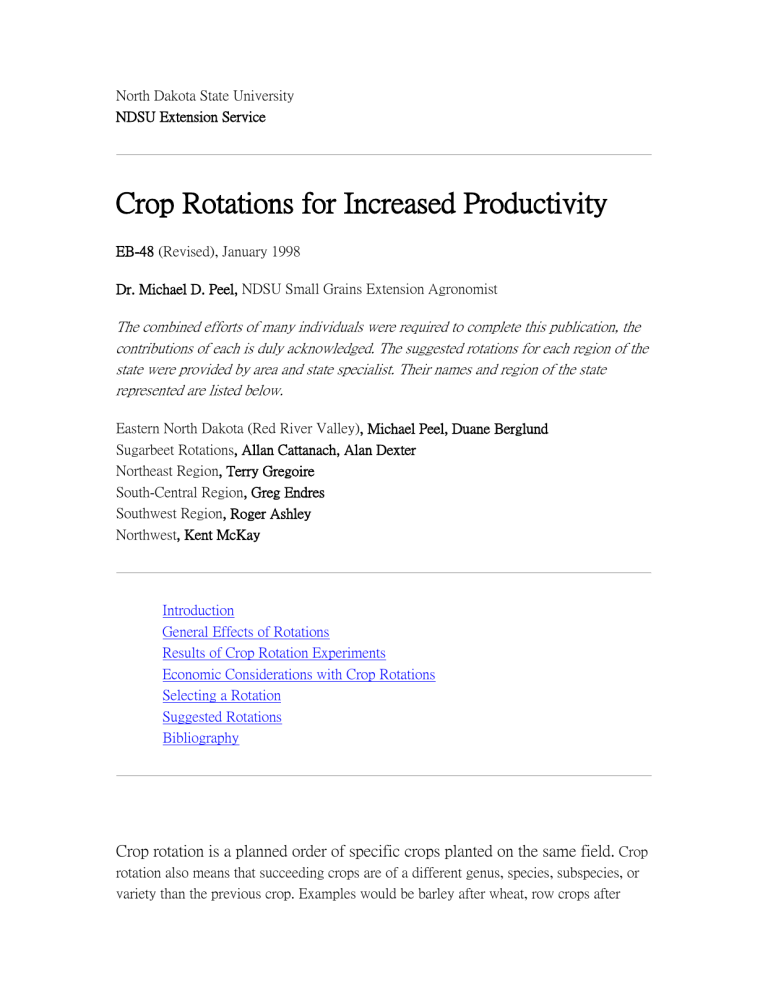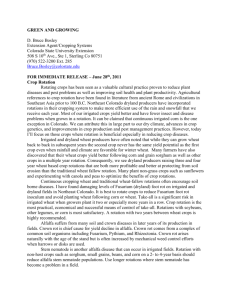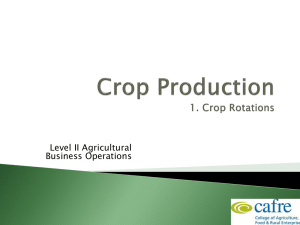Crop Rotations for Increased Productivity

North Dakota State University
NDSU Extension Service
Crop Rotations for Increased Productivity
EB-48 (Revised), January 1998
Dr. Michael D. Peel, NDSU Small Grains Extension Agronomist
The combined efforts of many individuals were required to complete this publication, the contributions of each is duly acknowledged. The suggested rotations for each region of the state were provided by area and state specialist. Their names and region of the state represented are listed below.
Eastern North Dakota (Red River Valley), Michael Peel, Duane Berglund
Sugarbeet Rotations, Allan Cattanach, Alan Dexter
Northeast Region, Terry Gregoire
South-Central Region, Greg Endres
Southwest Region, Roger Ashley
Northwest, Kent McKay
Introduction
General Effects of Rotations
Results of Crop Rotation Experiments
Economic Considerations with Crop Rotations
Selecting a Rotation
Suggested Rotations
Bibliography
Crop rotation is a planned order of specific crops planted on the same field.
Crop rotation also means that succeeding crops are of a different genus, species, subspecies, or variety than the previous crop. Examples would be barley after wheat, row crops after
small grains, grain crops after legumes, etc. The planned rotation sequence may be for a two- or three-year or longer period. Some of the general purposes of rotations are to improve or maintain soil fertility, reduce erosion, reduce the build-up of pests, spread the workload, reduce risk of weather damage, reduce reliance on agricultural chemicals, and increase net profits.
Crop rotations have fallen somewhat into disfavor because they require additional planning and management skills, increasing the complexity of farming. A shift away from livestock programs in most parts of North Dakota has also reduced the need for pasture and hay crops and eliminated some rotational crops such as alfalfa from many farms. Solid-seeded crops such as small grains and flax have predominated in the past, but row crops such as sunflower, pinto bean, corn and soybean provide additional planting options and more reasons for crop rotations.
General Effects of Rotations
One immediate economic benefit of crop rotations is improved yields. For example, sunflower yields over eight years at Crookston, Minnesota (24) were often significantly greater in rotation with other crops than when continuous sunflower was grown (Table 1).
Wheat yields were also greater with rotation than continuous wheat in an eight-year study
(22) conducted with different crops at Fargo (Table 2). A study at the Agriculture Research
Service at Mandan has shown that increased hard red spring wheat yields can be expected when an alternative crop is included in the rotation (27).
Table 1. Yields of sunflower following sunflower and in rotation with other crops at
Crookston, MN.
Previous Crop
Sunflower
Potato
Sugarbeet
Pinto Bean
Wheat
Sunflower yield, lb/A
1973 1975 1977 1978 4 yr Avg
852 1338 1852 1781 1456
908 1279 2348 1605 1535
770 1683 2358 2168 1745
946 1410 2282 1674 1578
1284 1549 2339 1655 1707
Source: Miscellaneous Report 166 - 1979, AES, University of Minnesota.
Table 2. Effect of previous crop on wheat yields, Fargo, ND (22).
Wheat yield, bu/A-Conventional tillage
Previous Crop 1977 1978 1979 1980 1981 1982 1983 1984 8 yr. Avg.
Wheat
Barley
22
27
26
25
35
35
37
37
34
42
39
46
43
48
16
18
31
35
Flax
Corn
Soybean
Sunflower
Sugarbeet
Average
31
31
42
29
34
31
37
32
43
33
34
33
36
43
42
44
41
39
35
37
42
41
38
38
37
45
46
45
44
42
47
53
49
39
43
44
43
39
54
43
52
46
37
38
45
44
47
35
38
38
45
40
42
Rotating to a different crop such as wheat on barley ground usually results in higher grain yields when compared to continuous cropping of wheat. Even greater benefits are usually obtained by rotating two distinctly unrelated crops, such as a small grain seeded into land where the previous crop was a legume or other herbaceous dicot such as flax or sunflower
(Table 2). Many of the reasons for the beneficial effects of rotations are not completely understood.
Some of the more important beneficial effects that can be obtained from a well planned crop rotation are:
Reduced insect and disease problems
Beneficial residual herbicide carryover
Improved soil fertility
Improvements in soil tilth and aggregate stability
Soil water management
Reduction of soil erosion
Reduction of allelopathic or phytotoxic effects
Pest control is often an important reason for crop rotation. Rotations can be used to prevent or partially control several pests and reduce the reliance on chemical and mechanical control. A combination of crop rotation and pesticides is often more effective in reducing
pest populations to economic levels than pesticides alone. Pesticides that provide economical control are not available for pests such as white mold in potato, dry bean, and sunflower, and crop rotations are the only feasible control method for reducing the impact of sclerotinia.
Disease control
Crop rotation has tremendous potential for reducing and often preventing the transmission of disease. Disease pressures change with changing environmental conditions. Table 3 lists examples of disease that can be controlled with rotation. Crop rotation, in combination with cultural practices plus necessary fungicides, is the most desirable method of disease control.
Table 3. Common disease controlled entirely or in part by rotation.
Disease
Common root rot
Ergot
Bacterial blights
Scab
Tan spot
Major Crops Attacked wheat, barley, grasses
1 rye, wheat, grasses wheat, barley, grasses, rye wheat, barley, corn, rye wheat, durum
Net blotch barley
Septoria (different species) wheat, barley
Septoria (different species) wheat
Septoria (different species) barley
Pasmo
Wilt (flax)
Rust (flax)
Seedling blight
Smut (corn)
Bacterial wilt flax flax
Best Control Methods
Rotation, seed trt.
Rotation, tillage
Rotation
Rotation
Rotation, fungicide
Rotation, fungicide
Rotation, fungicide
Rotation, fungicide
Rotation, fungicide
Rotation, variety
Rotation, variety flax Resistant Variety, rotation wheat, barley, corn, oats, rye Seed treatment corn alfalfa
Rotation
Variety resistance
Crown rot
Verticillium wilt
Rust (sunflower) alfalfa Variety resistance potato, sunflower, safflower Rotation, variety sunflower Variety, rotation
Sclerotinia (white mold) sunflower, dry beans safflower, soybean, potato, canola
Rotation 4 to 5 years
Phoma sunflower Rotation
1 Wheat includes durum.
Insect control
Insects which can be controlled entirely or in part by rotations are listed in Table 4. In addition, insect populations may become greater within a region where only one or two crops are continuously grown in contrast to a region where several crops are grown in rotation. Insects such as corn borer, sunflower seed and stem weevil, and many others readily migrate to nearby or distant fields. Therefore, only partial control can be obtained by rotation. Increasing field isolation from fields seeded to the same crop the previous year will often increase the effectiveness of crop rotation as an insect control method.
Table 4. Insects controlled partially or entirely by rotation.
Insect
Wheat stem sawfly
Wheat stem maggot
Hessian fly
Alfalfa weevil
Sweetclover weevil
Sunflower insects: moth, banded moth, stem weevil, midge and beetle
Corn rootworm
Sugarbeet, maggot and root aphid
Susceptible Crop
Wheat, rye
Wheat
Wheat
Alfalfa
Sweetclover
Sunflower, cultivated and wild
Corn
Sugarbeet
Weed control
Rotations can be used to cause shifts in weed populations. Populations of certain weed species can be suppressed by competition from the crop raised or by the selective use of herbicides. Wild mustard populations can be reduced by selective treatment of small grain
grown in rotation with row crops. Grass weed populations, often a problem in small grains, can be reduced by the use of the appropriate herbicide in the previous row crop.
Herbicides can have both beneficial and harmful residual effects on the next crop.
Therefore, planning the correct sequence of herbicide use together with crop selection has become a necessary part of rotation management. See Circular W-253, North Dakota Weed
Control Guide, for specific herbicides and their potential for carryover injury on a subsequent crop.
Soil nitrogen
Legumes in the rotation can be used to increase the available soil nitrogen. Symbiotic nitrogen-fixing bacteria called rhizobia form nodules on the roots of legume plants and convert or fix atmospheric nitrogen to organic nitrogen. The amount of nitrogen fixed varies with species, available soil nitrogen, and many other factors. Fixed nitrogen not removed from the land by harvest becomes available to succeeding crops as the legume tissues undergo microbial decomposition. When the legume crop is seeded, rhizobia inoculum should always be applied to the seed to ensure the most productive commercial strains are available to form nodules and that inoculating bacteria are always present. Even though indigenous bacteria may be present in the soil, research shows improved commercial strains of rhizobia have more capacity to fix nitrogen (28).
Legumes have the capacity to fix large amounts of nitrogen. Research in Minnesota (16) indicated that alfalfa fixed an average of 172 pounds of nitrogen annually during the first two years of production. However, only a portion of the nitrogen fixed is available to the next crop because much is removed in the harvested alfalfa. Nitrogen credits of various legume crops are listed in Table 5.
Table 5. Nitrogen credited to a subsequent crop of various legume crops, NDSU soil testing lab.
Previous Crop
Harvested
Alfalfa
Pinto bean
Soybean
Nitrogen
Credit lbs N/A
50
25
40
Field pea
Lentil
Navy bean
Sweetclover
20
20
25
50
Soil tilth and structure
Many farmers who rotate crops comment on the improvement in tilth or friability of soil following soybean or other row crops. In a Colorado study (25) involving corn, sugarbeet, and barley planted on succeeding years, soil aggregate stability was increased from 67 to
76 percent when three years of alfalfa were added to the rotation. Increased aggregate stability reduces the tendency of the soil to puddle or crust, increases rate of water infiltration under certain conditions, and may also reduce wind erosion.
Soil moisture
Crop rotation can lead to greater overall efficiency in soil water utilization. Spring seeded small grains usually deplete soil water 3 to 4 feet deep. In contrast, sunflower, safflower, corn and sugarbeet are deep-rooted crops which can deplete soil water to depths of 5 to 6 feet. Therefore, deep-rooted crops such as sunflower following small grains can take advantage of the extra reserve of deep moisture and also any nitrogen which was positionally unavailable to a shallow-rooted crop.
Alfalfa and sweetclover, also deep-rooted crops, can be used to dry up saline seeps and other wet areas. Depletion of soil water in saline areas prevents the accumulation of salts on the surface, permits movement of the salts downward by leaching, and allows recropping to a cash crop such as wheat. Alfalfa or sweetclover should be seeded on the upslope recharge area to use and remove soil water as deeply as possible from the soil profile, reducing lateral flow of water and salts into the saline seep discharge area (7).
Reduction of soil erosion
Crop rotations combined with recommended tillage practices can play an important role in reducing wind and water erosion. Solid seeded crops such as small grains provide more
protection against water erosion than row crops. Permanent crops such as hay or pasture provide even more protection against erosion. Management of crops to provide sufficient residue throughout the year is essential for satisfactory control of both wind and water erosion. No-till or minimum till farming is highly desirable as a conservation practice, but crop rotation must be used to reduce the buildup of insect, disease and weed pests.
Common pest problems associated with continuous no-till wheat have been Fusarium head blight (scab), wheat streak mosaic, root rots, tan spot, wheat stem sawfly, increases in winter annual grass species, and serious infestation of perennial noxious weeds such as quackgrass and Canada thistle. Other crops grown continuously have had similar types of problems.
The effect of various crop rotations (29) on soil erosion is vividly illustrated in Table 6.
The addition of barley and hay or pasture to the rotation was estimated to reduced the degree of soil erosion by more than 50 percent when compared to continuous corn. The expected reduction in soil erosion would be even greater on steeper slopes.
Table 6. Expected soil losses in tons per acre per year from croping systems on moderately eroded slopes, Wisconsin Agri. Expt. Sta., Bulletin 452, 1941.
Cropping System
Corn annually
Corn, barley (sweetclover)*
Corn, barley, hay
Corn, corn, barley, 3 yrs. hay
Corn, barley, 2 yrs. hay
Corn, barley, 3 yrs. hay
Corn, barley, 4 yrs. hay
Corn, barley, 6 yrs. hay
Corn, barley, 10 yrs. hay
*Underseeded with sweetclover.
Allelopathy-phytotoxicity
Percent Slope
3 6 9 12 15 16 18 24
- - - - - - - Tons soil lost per acre - - - - - - -
5 12 22 44 76 89 117 242
2 4 8 16 28 33 44 90
1 3 6 11 19 22 29 60
1 3 5 10 17 20 26 54
1 2 3 6 11 13 17 35
0.5
1 2 4 7 8 10 22
0.5
1 2 3 6 7 9 19
0.5
1 1 2 3 5
0.2
0.5
1 1 2 3
7
4
14
8
The reasons for improved yields due to crop rotations are not completely understood.
Research has attempted to reveal some of the unknown factors. Terms such as phytotoxicity, allelopathy and autotoxicity are coming into common usage. Phytotoxicity, a general term, is defined as chemical that is toxic to plant growth whether it is derived from plant products or synthetic (herbicide or other pesticide residues). Allelopathy refers to plant material or chemicals derived from these materials which inhibit the germination, growth or development of another species. Autotoxicity refers to plant material which inhibits the germination, growth and development of the same species.
Legumes such as alfalfa, while often beneficial to non-related species, exhibit autotoxic effects to alfalfa seedlings. Research in Illinois indicated older stands caused greater inhibition of new seedlings (Table 7). This study (21) indicated that one year out of alfalfa was sufficient to nullify the detrimental effects of the alfalfa.
Table 7. Alfalfa yields reestablished annually in Illinois.
Year Established* Yield Tons/Acre
1st 4.5
2nd
3rd
4.3
3.8
4th
5th
6th
7th
3.1
2.5
2.1
1.1
[NEXT]
[ Results of Crop Rotation Experiments ]
[ Economic Considerations with Crop Rotations ]
[ Selecting a Rotation ] [ Suggested Rotations ] [ Bibliography ]
EB-48 (Revised), January 1998
NDSU Extension Service, North Dakota State University of Agriculture and Applied
Science, and U.S. Department of Agriculture cooperating. Sharon D. Anderson, Director,
Fargo, North Dakota. Distributed in furtherance of the Acts of Congress of May 8 and June
30, 1914. We offer our programs and facilities to all persons regardless of race, color, national origin, religion, sex, disability, age, Vietnam era veterans status, or sexual orientation; and are an equal opportunity employer.
This publication will be made available in alternative formats for people with disabilities upon request, 701/231-7881.
North Dakota State University
NDSU Extension Service






